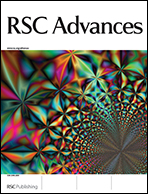Spontaneous formation of branched nanochains from room temperature molten amides: visible and near-IR active, SERS substrates for non-fluorescent and fluorescent analytes†
Abstract
Highly stable, branched gold nanoworms are formed spontaneously in an acetamide-based room temperature molten solvent without any additional external stabilizing or aggregating agent. The nanoworms can be anchored onto solid substrates such as indium tin oxide (ITO) without any change in morphology. The anchored nanoworms are explored as substrates for surface enhanced Raman scattering (SERS) studies using non-fluorescent 4-mercaptobenzoic acid (4-MBA) and fluorescent rhodamine 6G (R6G) as probe molecules. The anchored nanostructured particles respond to near IR (1064 nm) as well as visible (785, 632.8 and 514 nm) excitation lasers and yield good surface enhancement in Raman signals. Enhancement factors of the order 106–107 are determined for the analytes using a 1064 nm excitation source. Minimum detection limits based on adsorption from ethanolic solutions of 10−8 M 4-MBA and aqueous solutions of 10−7 M R6G are achieved. Experimental Raman frequencies and frequencies estimated by DFT calculations are in fairly good agreement. SERS imaging of the nanostructures suggests that the substrates comprising of three dimensional, highly interlinked particles are more suited than particles fused in one dimension. The high SERS activity of the branched nanoworms may be attributed to both electromagnetic and charge transfer effects.


 Please wait while we load your content...
Please wait while we load your content...